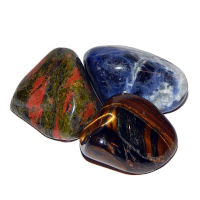This gemstone is one that is both popular and affordable. Perhaps most easily distinguishable by its parallel wave effect, this silky stone can prove to be an attractive choice for your jewellery.
Characteristics

The Tiger's Eye owes its silky appearance to its structure – parallel lines contribute to a captivating silky look. It is opaque, and does not seem to appear in translucent or transparent variations. In addition, it is a relatively hard gemstone, usually rated between 6 to 7 (out of 10) on the Mohs hardness scale.
Generally, these gemstones are not subjected to additional heat treatment or any other artificial modification in order to achieve a desired appearance. However, it is possible for some of the red or maroon toned stones to have been dyed to achieve the colour.
Interestingly, a Cat Eye effect can be encountered in Tiger Eye gemstones even though it is quite a rare characteristic.
It should be noted that in order to achieve the most visually appealing look, the Tiger's Eye stone should be very carefully cut if one wishes to create a gemstone cut. By doing so, the resulting gemstone will exhibit a brilliant reflection across its surface. Most commonly, this is achieved by cutting the gem into a cabochon shape.
Colour
Tiger's Eye exhibits tones such as yellow, brown or red. In addition, more often than not those tones are accompanied by darker elements of black. As such it can be said the stone is multicoloured. It generally does not appear in colder tones but some stones can be found to exhibit a blue tone. That said, a blue Tiger Eye is generally referred to as a "Hawk's Eye".
One variety of particular interest is the Marra Mamba Tiger's Eye, an Australian variety. It exhibits a multicolour appearance, composed of tones of yellow, red, yellowish-green and even hints of blue. Thanks to its unique appearance, the Tiger's Eye is difficult to confuse with other gemstones which makes it easier to shop for.
Use
Tiger's Eye stones are generally used in jewellery as settings in pendants, as well as bracelet beads, and necklaces. It can be used in costume jewellery, and even larger gemstone cuts – though those are considered to be quite uncommon. Finally, it can also be used for carvings which makes it a rather versatile stone.
Sources
The most important source of Tiger's Eye is South Africa. The abundant deposits in Northern Cape are extensive enough on their own to make this gemstone an affordable one. It is, however, available in other locations as well. These include: Asia (Thailand, China, and India), Australia and Namibia. It can also be found in both Americas (in particular, Brazil and Canada).









